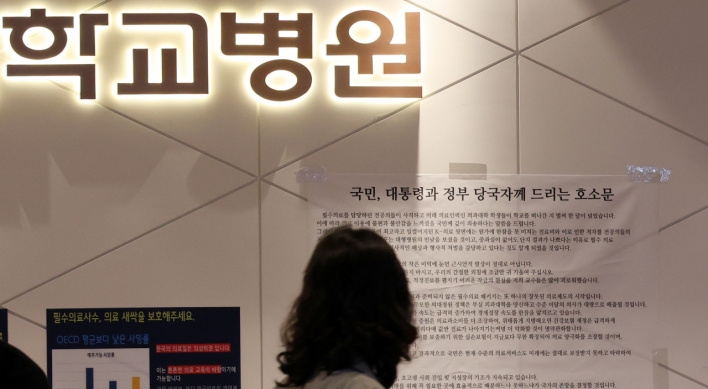When Korean Wave pioneer “Jewel in the Palace (Daejanggeum)” swept across Asia from 2004 to 2006, royal cuisine -- spun out by the hands of the series’ heroine, Jang-geum, and the series’ kitchen court ladies -- transfixed viewers with its sumptuous brilliance and intricate nature.
Mouths watered. Palates tingled with the desire to savor the parade of dishes, so evocatively presented in lush, vibrant colors and textures.
International viewers were awakened to a realm of hansik that went beyond the standard trinity: kimchi, Korean BBQ and bibimbap.
Interests were piqued.
Restaurants called Daejanggeum sprung up throughout Asia, a sign that while actress Lee Young-ae’s Jang-geum had enraptured Asian audiences with her heartfelt story, it was the culinary creations of the Institute of Korean Royal Cuisine president Han Bok-ryo that had excited their palates.
“I made food with the institute’s students,” Han detailed her work as food consultant for MBC’s “Jewel in the Palace” (2003).
Mouths watered. Palates tingled with the desire to savor the parade of dishes, so evocatively presented in lush, vibrant colors and textures.
International viewers were awakened to a realm of hansik that went beyond the standard trinity: kimchi, Korean BBQ and bibimbap.
Interests were piqued.
Restaurants called Daejanggeum sprung up throughout Asia, a sign that while actress Lee Young-ae’s Jang-geum had enraptured Asian audiences with her heartfelt story, it was the culinary creations of the Institute of Korean Royal Cuisine president Han Bok-ryo that had excited their palates.
“I made food with the institute’s students,” Han detailed her work as food consultant for MBC’s “Jewel in the Palace” (2003).
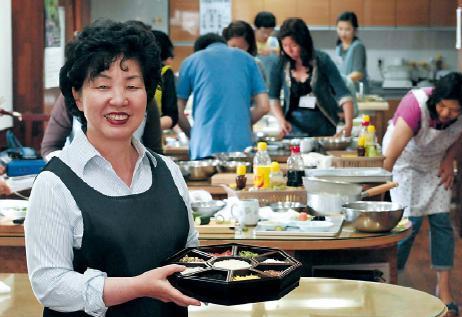
But do not mistake Han for a run-of-the-mill food consultant. Considering her background in court cuisine, she is a major authority on Korean palatial food.
Preserving an edible legacy
Han’s relationship with royal cuisine runs deep.
Han is the third holder of the title of the 38th Important Intangible Cultural Property (Royal Cuisine of the Joseon Dynasty). Her mother, the late Hwang Hye-seong (1920-2006), was the second holder of the title, who trained under the first holder of the title, the last Joseon Dynasty kitchen court lady, Han Hui-sun (1889-1972).
Furthermore, since the government-designated title needs to be carried on, Han’s two younger sisters, Han Bok-sun and Han Bok-jin, are initiates for the title.
In essence, this is a family affair, one that stretches over to her brother, Han Yong-kyu.
After Han and her mother established the Institute of Korean Royal Cuisine in 1971 and their first palatial food restaurant, Jihwaja, in 1991, her brother took over the task of running Jihwaja (there are currently two restaurants) and Goongyeon (a royal food restaurant started by Han Bok-ryo in 2005), allowing Han, who remains a consultant for all three establishments, to focus on her role as the institute’s president.
Now, at the age of 63, Han still teaches regularly, imparting her knowledge to those who are interested. Vivacious but visibly worn from her busy schedule, she embodies the fragile yet tenacious nature of a culinary legacy.
“It became fate, in a sense, because I needed to carry on the institute, the work of passing this down,” she said, the weight of her responsibility hung heavy in her words. Yet, it seemed like a duty she was glad to have.
Kitchen court ladies
To begin to understand why Han Hui-sun, the last Joseon Dynasty kitchen court lady, was designated the first holder of the 38th Important Intangible Cultural Property; one must first understand what a kitchen court lady is.
According to Han Bok-ryo and Chung Kil-ja’s “Joseon Dynasty Korean Royal Cuisine” (The Institute of Korean Royal Cuisine, 2009), kitchen court ladies were responsible for preparing the royal family’s regular meals, while male cooks were responsible for royal banquets.
In order to become a kitchen court lady, one needed to enter the palace at around the age of 13 and train for over 30 years. As a result, one generally became a kitchen court lady past the age of 40.
“The best ingredients were brought in, a diverse range, because it was the palace, and professionals made it for the country’s most powerful being,” Han said, referring to the highly experienced kitchen court lady and her male counterpart.
Sura: The royal meal
According to “Joseon Dynasty Korean Royal Cuisine,” the king dined on “sura,” his main meals, at around 10 a.m. and 5 p.m. At the break of dawn, he enjoyed “chojoban” -- usually a type of porridge or a medicinal brew. In between his morning and evening sura he would have “natgeot” -- usually clear soup or tea and sweets -- and after his evening sura he would have “yacham” -- noodles, sweet rice with nuts and Korean dates, “sikhye” (rice punch) or milk porridge. This meant that the king ate approximately five times a day.
His most elaborate daily meals were sura, which, according to The Institute of Korean Royal Cuisine, consisted of two types of rice, two soups, three kinds of kimchi, two stews, three sauces and one steamed dish. Side dishes, a total of 12, also accompanied the meal.
Sura was more than just food; it was a reflection of the crops harvested and the fish and meat caught and hunted by the country’s people. The food-laden table allowed the king to indirectly observe his people and the conditions of their crops and the land.
“The king would taste a side dish first and then after chewing and savoring it, he would cleanse his palate with a little bit of rice,” Lee Soon-hwa, food and beverage team director of the court cuisine company Jihwaja, explained. “Therefore in order to eat all those different dishes, the food was somewhat blandly seasoned.”
A surprising lack of salty dishes is not the only defining characteristic of royal cuisine. Health was stressed as well as the abundant use of garnishes (including the white and yellow strips of omelet called “jidan”), pine nut powder and three kinds of soy sauce, said Lee.
Court cuisine, however, is not drastically different from hansik as a whole.
According to “Joseon Dynasty Korean Royal Cuisine,” the reason why palace food and hansik in general bear similarities to each other was because royalty did not wed one another. Instead, they wed nobility, resulting in an exchange of food, where dishes were traded up to court and dishes were traded down from the palace. Furthermore, food from royal banquets was given to the public, enabling them to develop a taste for court cuisine also.
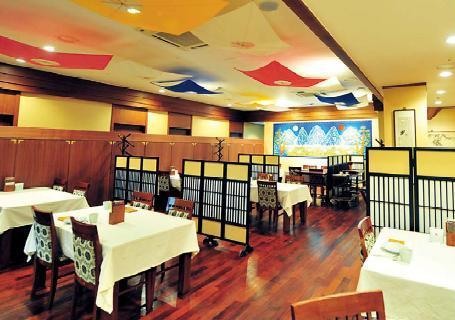
Jihwaja: Dining like royalty
Enjoying court cuisine in its original form would most likely require sitting through a five-meal day.
Jihwaja, located at The National Theater of Korea, offers up an abbreviated affair in the form of a six-course meal aptly named “Royal Court Dinner” (65,000 won).
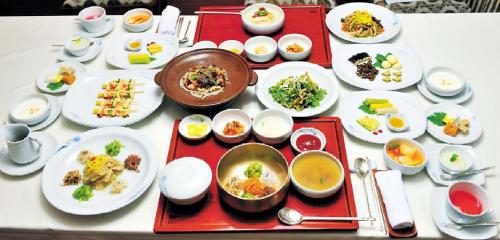
Raw chestnuts, fried bows of kelp and pumpkin seeds ground and mixed with honey initiate the diner into the world of royal cuisine.
A creamy porridge of milk, called tarak-juk, pays homage to the king’s chojoban.
“At 5 a.m., before the bedding was cleared away, the king enjoyed a meal called chojoban or jaritjoban,” said Jihwaja’s Lee. “Since his intestines had rested all night, he dined on milk porridge to lightly jump start his digestive system.”
The silken delicacy, mild and slightly sweet, is followed by a revamped form of the “gujeolpan,” where the eight seasoned vegetables and meat come pre-wrapped in their translucent pancakes.
A healthy salad made of blanched and seasoned slices of burdock root, vegetables, pyogo mushrooms and meat and sprinkled with a savory mixture of soy sauce, vinegar and sugar, is delicious all by itself. In fact, none of these dishes require an accompaniment of rice. Though not bland, they are not salty or spicy.
“The flavors of (court cuisine) are not too strong, they highlight the original flavors of the ingredients themselves,” Lee explained.
Beef brisket sizzling on an earthenware pot and paired with a delicious and zesty ginseng-based salad, “japchae” (clear noodles with vegetables), skewers of shrimp adorned with lines of pine nut sauce and bibimbap make for a meal that, while hearty, is not heavy.
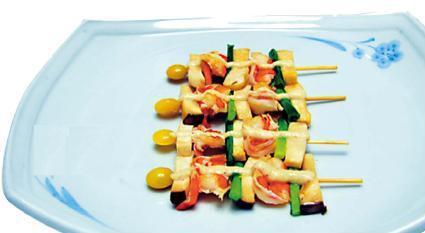
Dessert -- a small rice cake, fruit and “yakgwa” -- rounds out the meal. The yakgwa, a deep-fried sweet that runs somewhere between a croissant and baklava, is phenomenal.
“It is called Gaesong yakgwa,” said Lee, who explained that flour was very precious in the past and that it was mixed with sesame seed oil. Honey and syrup were added to form the dough. “Then it was rolled out, cut in half. One layer was placed over the other and then rolled out again.”
Lee described how the multiple layers would turn into the flaky delicious pastry known as yakgwa.
After the meal has ended, there is an overall sense of having just consumed something incredibly healthy, beautiful and delicious.
“Royal cuisine takes your health into consideration and enables you to digest your food comfortably,” said Lee.
Details
For more information on The Institute of Royal Cuisine visit www.food.co.kr or call (02) 3673-1122.
The National Theater of Korea branch of Jihwaja is located near Dongguk Univ. Subway Station Line 3. For more information call (02) 2269-5834 or visit www.jihwajafood.co.kr for more information on Jihwaja and Goongyeon.
By Jean Oh (oh_jean@heraldcorp.com)
“It is called Gaesong yakgwa,” said Lee, who explained that flour was very precious in the past and that it was mixed with sesame seed oil. Honey and syrup were added to form the dough. “Then it was rolled out, cut in half. One layer was placed over the other and then rolled out again.”
Lee described how the multiple layers would turn into the flaky delicious pastry known as yakgwa.
After the meal has ended, there is an overall sense of having just consumed something incredibly healthy, beautiful and delicious.
“Royal cuisine takes your health into consideration and enables you to digest your food comfortably,” said Lee.
Details
For more information on The Institute of Royal Cuisine visit www.food.co.kr or call (02) 3673-1122.
The National Theater of Korea branch of Jihwaja is located near Dongguk Univ. Subway Station Line 3. For more information call (02) 2269-5834 or visit www.jihwajafood.co.kr for more information on Jihwaja and Goongyeon.
By Jean Oh (oh_jean@heraldcorp.com)



![[Herald Interview] 'Amid aging population, Korea to invite more young professionals from overseas'](http://res.heraldm.com/phpwas/restmb_idxmake.php?idx=644&simg=/content/image/2024/04/24/20240424050844_0.jpg&u=20240424200058)









